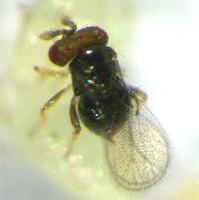|
Rice horned caterpillar
| Symptom of Damage : |
- Larva feeds on leaf blades of rice.
- Leaves are defoliated from the margin or tip irregularly.
|
 |
 |
| Mining of leaves by grubs |
Presence of beetles with scrapping on leaves |
|
| Top |
| Identification of pest : |
|
Scientific Name - Melanitis leda ismene
- Egg :
White, round laid singly on the paddy leaves.
- Larva :
Green with roughened skin flattened dorsally and has a dark brown head with a pair of red horn like processed and two yellow processes in the anal end. It feeds on the leaves.
- Pupa :
Dark green chrysalis hangs from the leaf and is attached to the leaf blade by its anal extremity.
- Adult :
The butterfly is dark brown with large wings having a few black and yellow eye-like markings one on each of the forewings and six ocellar spots on hind wings. |
 |
 |
| Rice horned caterpillar |
Rice horned caterpillar |
 |
|
| Rice horned caterpillar adult |
|
| Top |
| Management Strategies: |
|
- Expose the eggs to be picked up by birds after ploughing and trim the bunds.
- Dusting the crop with 5-10% methyl parathion 2% @ 25-30 kg/ha. fenitrothion (or) malathion 5% @ 20 kg/ha.
- Spraying nuvan 100 EC @ 200 ml/ha (or) malathion 50 EC@ 2.5 lit/ha.
- Bio-control agents such as Cacallus spp., Barycomus spp. and Seelio spp., which are egg parasites should be encouraged.
- The eggs are parasitized by trichogrammatid wasps.
- Chalcid wasp and two species of tachinid flies parasitize the larvae and a vespid wasp preys on the larvae.
|
 |
| Trichogramma japonicum |
 |
|
| Flood the nursery to expose hiding larvae |
| Top |
|







